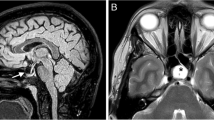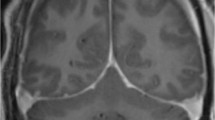Abstract
The specific aim of this review is to report the features of intracranial pressure changes [spontaneous intracranial hypotension (SIH) and idiopathic intracranial hypertension (IIH)] in children and adolescents, with emphasis on the presentation, diagnosis, and treatment modalities. Headache associated with intracranial pressure changes are relatively rare and less known in children and adolescents. SIH is a specific syndrome involving reduced intracranial pressure with orthostatic headache, frequently encountered connective tissue disorders, and a good prognosis with medical management, initial epidural blood patching, and sometimes further interventions may be required. IIH is an uncommon condition in children and different from the disease in adults, not only with respect to clinical features (likely to present with strabismus and stiff neck rather than headache or pulsatile tinnitus) but also different in outcome. Consequently, specific ICP changes of pediatric ages required specific attention both of exact diagnosis and entire management.
Similar content being viewed by others
References
Papers of particular interest, published recently, have been highlighted as: • Of importance •• Of major importance
Amorim JA. Gomes de Barros MV, Valença MM. Post-dural (post-lumbar) puncture headache: risk factors and clinical features. Cephalalgia. 2012;32:916–23.
Schaltenbrand G. Neuere Anschauungen zur Pathophysiologie der Liquorzirkulation. Zentralbl Neurochir. 1938;3:290–300.
Messori A, Simonetti BF, Regnicolo L, Di Bella P, Logullo F, Salvolini U. Spontaneous intracranial hypotension: the value of brain measurements in diagnosis by MRI. Neuroradiology. 2001;43:453–61.
Schievink WI. Spontaneous spinal cerebrospinal fluid leaks and intracranial hypotension. JAMA. 2006;295:2286–96.
Schievink WI, Maya MM, Louy C, Moser FG, Sloninsky L. Spontaneous intracranial hypotension in childhood and adolescence. J Pediatr. 2013;163:504–10. A comprehensive review of an expert of SIH in the aspect of children and adolescents. This paper gives us not only the clinical course of the disorder but also diagnosis and management cornerstones.
Syed NA, Mirza FA, Pabaney AH, Rameez-ul-Hassan. Pathophysiology and management of spontaneous intracranial hypotension-a review. J Pak Med Assoc. 2012;62:51–5. An important paper that gives a multidisciplinary approach to this disorder including detailed laboratory data and management strategies.
Schievink WI, Maya MM, Moser FG, Tourje J. Spectrum of subdural fluid collections in spontaneous intracranial hypotension. J Neurosurg. 2005;103:608–13.
Schievink WI, Morreale VM, Atkinson JLD, Meyer FB, Piepgras DG, Ebersold MJ. Surgical treatment of spontaneous spinal cerebrospinal fluid leaks. J Neurosurg. 1998;88:243–6.
Hain TC, Cherchi M, Yacovino DA. Bilateral vestibular loss. Semin Neurol. 2013;33:195–203.
Schievink WI, Meyer FB, Atkinson JL, Mokri B. Spontaneous spinal cerebrospinal fluid leaks and intracranial hypotension. J Neurosurg. 1996;84:598–605.
Mokri B. Spontaneous cerebrospinal fluid leaks: from intracranial hypotension to cerebrospinal fluid hypovolemia - evolution of a concept. Mayo Clin Proc. 1999;74:1113–23.
Wilmott RW. Pediatric spontaneous intracranial hypotension. J Pediatrics. 2013;163:309–11.
Paldino M, Mogilne A, Tenner M. Intracranial hypotension syndrome: a comprehensive review. Neurosurg Focus. 2003;15:ECP2.
Pannullo SC, Reich JB, Krol G, Deck MD, Posner JB. MRI changes in intracranial hypotension. Neurology. 1993;43:919–26.
Vishteh AG, Spetzler RF. Vascular compression syndrome. J Neurosurg. 1998;89:502–3.
The International Classification of Headache Disorders, 3rd edition (beta version). Headache Classification Committee of the International Headache Society (IHS). Cephalalgia. 2013;33:629–808.
Balkan II, Albayram S, Ozaras R, Yilmaz MH, Ozbayrak M, Mete B, et al. Spontaneous intracranial hypotension syndrome may mimic aseptic meningitis. Scand J Infect Dis. 2012;44:481–8.
Pakiam AS, Lee C, Lang AE. Intracranial hypotension with parkinsonism, ataxia, and bulbar weakness. Arch Neurol. 1999;56:869–72.
Hochman SM, Naidich TP. Diffuse meningeal enhancement in patients with overdraining, long-standing ventricular shunts. Neurology. 1999;15:406–9.
Rando TA, Fishman RA. Spontaneous intracranial hypotension: report of two cases and review of the literature. Neurology. 1992;42(3 Pt 1):481–7.
Renowden SA, Gregory R, Hyman N, Hilton-Jones D. Spontaneous intracranial hypotension. J Neurol Neurosurg Psychiatry. 1995;59:511–5.
Yamamoto M, Suehiro T, Nakata H. Primary low cerebrospinal fluid pressure syndrome associated with galactorrhea. Intern Med. 1993;32:228–31.
Chen CC, Luo CL, Wang SJ, Chern CM, Fuh JL, Lin SH, et al. Colour Doppler Imaging for diagnosis of intracranial hypotension. Lancet. 1999;354:826–9.
Shankar JJ, Chakraborty S, Lum C. The venous hinge—an objective sign for the diagnosis and follow-up of treatment in patients with intracranial hypotension syndrome. Neuroradiology. 2009;51:453–6.
Schievink WI, Maya MM, Moser FM. Treatment of spontaneous intracranial hypotension with percutaneous placement of a fibrin sealant: report of four cases. J Neurosurg. 2004;100:1098–100.
Dandy WE. Intracranial pressure without brain tumor: diagnosis and treatment. Ann Surg. 1937;106:492–513.
Lessell S. Pediatric pseudotumor cerebri (idiopathic intracranial hypertension.). Surv Ophthalmol. 1992;33:155–66.
Cinciripini GS, Donahue S, Borchert MS. Idiopathic intracranial hypertension in prepubertal pediatric patients: characteristics, treatment, and outcome. Am J Ophthalmol. 1999;127:178–82. An important retrospective report of 10 patients with puberty suggested by comprehensive literature review and specific discussion about pathophysiology.
Dessardo NS, Dessardo S, Sasso A, Sarunić AV, Dezulović MS. Pediatric idiopathic intracranial hypertension: clinical and demographic features. Coll Antropol. 2010;34 Suppl 2:217–21.
Rangwala LM, Liu GT. Pediatric idiopathic intracranial hypertension. Surv Ophthalmol. 2007;52:597–617.
Shaw GY, Million SK. Case Report. Benign intracranial hypertension: a diagnostic dilemma. Case Rep Otolaryngol. 2012;2012:814696.
Robertson WC, Chawla J, Sheth RD, Talavera F, Mack KJ, Benbadis SR, et al. Medscape. 2012. Available at: http://emedicine.medscape.com/article/1179733).
Babikian P, Corbett J, Bell W. Idiopathic intracranial hypertension in children: the Iowa experience. J Child Neurol. 1994;9:144–9.
Gordon K. Pediatric pseudotumor cerebri: descriptive epidemiology. Can J Neurol Sci. 1997;24:219–21.
Jindal M, Hiam L, Raman A, Rejali D. Idiopathic intracranial hypertension in otolaryngology. Eur Arch Otorhinolaryngol. 2009;266:803–6.
Distelmaier F, Sengler U, Messing-Juenger M, Assmann B, Mayatepek E, Rosenbaum T. Pseudotumor cerebri as an important differential diagnosis of papilledema in children. Brain Dev. 2006;28:190–5.
Standridge SM. Idiopathic intracranial hypertension in children: a review and algorithm. Pediatr Neurol. 2010;43:377–90.
Johnston IH, Duff J, Jacobson EE, Fagan E. Asymptomatic intracranial hypertension in disorders of CSF circulation in childhood—treated and untreated. Pediatr Neurosurg. 2001;34:63–72.
Farb RI, Vanek I, Scott JN, Mikulis DJ, Willinsky RA, Tomlinson G, et al. Idiopathic intracranial hypertension: the prevalence and morphology of sinovenous stenosis. Neurology. 2003;60:1418–24.
Ekizoglu E, Içoz S, Tuzun E, Birisik O, Kocasoy-Orhan E, Akman-Demir G, et al. Aquaporin-4 antibodies are not present in patients with idiopathic intracranial hypertension. Cephalalgia. 2012;32:198–202.
Szewka AJ, Bruce BB, Newman NJ, Biousse V. Pediatric idiopathic intracranial hypertension and extreme childhood obesity: a comment on visual outcomes. J Pediatr. 2012;161:972.
Brara SM, Koebnick C, Porter AH, Langer-Gould A. Pediatric idiopathic intracranial hypertension and extreme childhood obesity. J Pediatr. 2012;161:602–7.
Scott IU, Siatkowski RM, Eneyni M, Brodsky MC, Lam BL. Idiopathic intracranial hypertension in children and adolescents. Am J Ophthalmol. 1997;124:253–5.
Binder DK, Horton JC, Lawton MT, McDermott MW. Ideopathic intracranial hypertension. Neurosurgery. 2004;54:538–52.
Higgins JNP, Gillard JH, Owler BK, Harkness K, Pickard JD. MR venography in idiopathic intracranial hypertension: unappreciated and misunderstood. J Neurol Neurosurg Psychiatry. 2004;75:621–5.
Youroukos S, Psychou F, Fryssiras S, Paikos P, Nicolaidou P. Idiopathic intracranial hypertension in children. J Child Neurol. 2000;15:453–7.
Ertekin V, Selimoglu MA, Tan H. Pseudotumor cerebri due to hypervitaminosis a or hypervitaminosis d or both in Alagille syndrome. Headache. 2010;50:152–3.
Phillips PH, Repka MX, Lambert SR. Pseudotumor cerebri in children. J AAPOS. 1998;2:33–8.
Hacifazlioglu Eldes N, Yilmaz Y. Pseudotumour cerebri in children: etiological, clinical features and treatment modalities. Eur J Paediatr Neurol. 2012;16:349–55.
Incecik F, Hergüner MO, Altunbasak S. Evaluation of sixteen children with pseudotumor cerebri. Turk J Pediatr. 2011;53:55–8. An important report discusses the importance of obesity and outcome measures.
Salman MS, Kirkham FJ, MacGregor DL. Idiopathic “benign” intracranial hypertension: case series and review. J Child Neurol. 2001;16:465–70.
Ozge A, Termine C, Antonaci F, Natriashvili S, Guidetti V, Wober-Bilgol C. Overview of diagnosis and management of paediatric headache. Part I: diagnosis. J Headache Pain. 2011;12:13–23.
Ravid S, Shachor-Meyouhas Y, Shahar E, Kra-Oz Z, Kassis I. Reactivation of varicella presenting as pseudotumor cerebri: three cases and a review of the literature. Pediatr Neurol. 2012;46:124–6.
Tibussek D, Schneider DT, Vandemeulebroecke N, Turowski B, Messing-Juenger M, Willems PH, et al. Clinical spectrum of the pseudotumor cerebri complex in children. Childs Nerv Syst. 2010;26:313–21.
Obeid M, Price J, Sun L, Scantlebury MH, Overby P, Sidhu R, et al. Facial palsy and idiopathic intracranial hypertension in twins with cystic fibrosis and hypovitaminosis A. Pediatr Neurol. 2011;44:150–2.
Wolf A, Hutcheson KA. Advances in evaluation and management of pediatric idiopathic intracranial hypertension. Curr Opin Ophthalmol. 2008;19:391–7.
Komur M, Sari A, Okuyaz C. Simultaneous papilledema and optic disc drusen in a child. Pediatr Neurol. 2012;46:187–8.
Soler D, Cox T, Bullock P. Diagnosis and management of benign intracranial hypertension. Arch Dis Child. 1998;78:89–94.
Jonas JB, Harder B. Ophthalmodynamometric estimation of cerebrospinal fluid pressure in pseudotumour cerebri. Br J Ophthalmol. 2003;87:361–2.
Ophir A, Karatas M, Ramirez JA, Inzelberg R. OCT and chronic papilledema. [letter]. Ophthalmology. 2005;112:2238.
Trick GL, Bhatt SS, Dahl D, Skarf B. Optic disc topography in pseudopapilledema: a comparison with pseudotumor cerebri. J Neuroophthalmol. 2001;21:240–4.
Brodsky MC, Vaphiades M. Magnetic resonance imaging in pseudotumor cerebri. Ophthalmology. 1998;105:1686–93.
Hutzelmann A, Buhl R, Freund M. Pseudotumour cerebri and optic hydrops—magnetic resonance imaging diagnostic and therapeutic considerations in a paediatric case. Eur J Radiol. 1998;28:126–8.
Takanashi J, Suzuki H, Nagasawa K, Kobayashi K, Saeki N, Kohno Y. Empty sella in children as a key for diagnosis. Brain Dev. 2001;23:422–3.
Shofty B, Ben-Sira L, Constantini S, Freedman S, Kesler A. Optic nerve sheath diameter on MR Imaging: establishment of norms and comparison of pediatric patients with idiopathic intracranial hypertension with healthy controls. Am J Neuroradiol. 2012;33:366–9.
Friedman DI, Jacobson DM. Idiopathic intracranial hypertension. J Neuroophthalmol. 2004;24:138–45.
Matthews YY. Drugs used in childhood idiopathic or benign intracranial hypertension. Arch Dis Child Educ Pract Ed. 2008;93:19.
Chern JJ, Tubbs RS, Gordon AS, Donnithorne KJ, Oakes WJ. Management of pediatric patients with pseudotumor cerebri. Childs Nerv Syst. 2012;28:575–8.
Per H, Canpolat M, Gümüs H, Poyrazoğlu HG, Yıkılmaz A, Karaküçük S, et al. Clinical spectrum of the pseudotumor cerebri in children: etiologic, clinical features, treatment and prognosis. Brain Dev. 2013;35:561–8.
Phillips PH. Pediatric pseudotumor cerebri. Int Ophthalmol Clin. 2012;52:51–9.
Soiberman U, Stolovitch C, Balcer LJ, Regenbogen M, Constantini S, Kesler A. Idiopathic intracranial hypertension in children: visual outcome and risk of recurrence. Childs Nerv Syst. 2011;27:1913–8.
Stiebel-Kalish H, Kalish Y, Lusky M, Gaton DD, Ehrlich R, Shuper A. Puberty as a risk factor for less favorable visual outcome in idiopathic intracranial hypertension. Am J Ophthalmol. 2006;142:279–83.
Compliance with Ethics Guidelines
ᅟ
Conflict of Interest
Aynur Özge and Hayrunnisa Bolay declare that they have no conflicts of interest.
Human and Animal Rights and Informed Consent
This article does not contain any studies with human or animal subjects performed by any of the authors.
Author information
Authors and Affiliations
Corresponding author
Additional information
This article is part of the Topical Collection on Childhood and Adolescent Headache
Rights and permissions
About this article
Cite this article
Özge, A., Bolay, H. Intracranial Hypotension and Hypertension in Children and Adolescents. Curr Pain Headache Rep 18, 430 (2014). https://doi.org/10.1007/s11916-014-0430-7
Published:
DOI: https://doi.org/10.1007/s11916-014-0430-7




